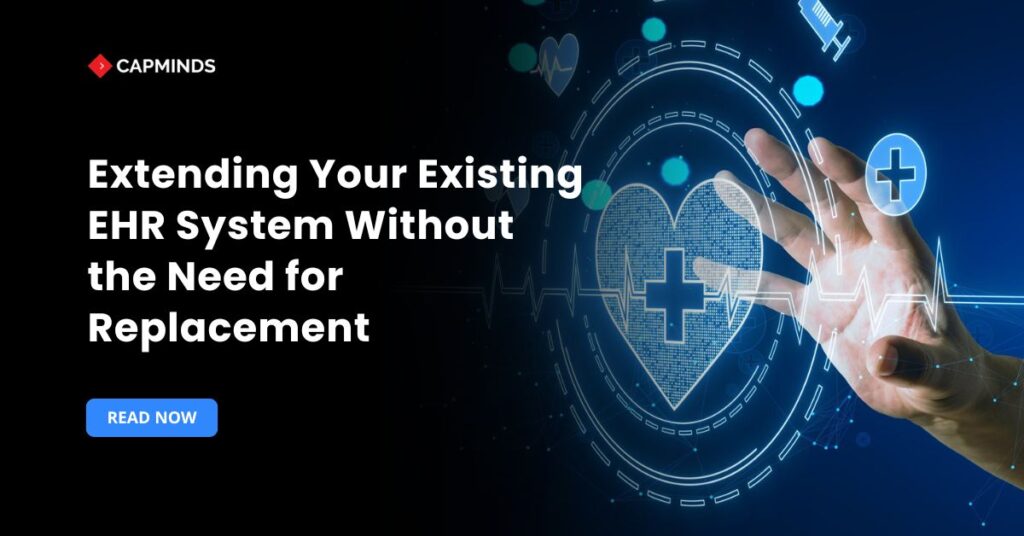Extending Your Existing EHR System Without the Need for Replacement
Healthcare organizations frequently find themselves at a crossroads when their EHR systems no longer meet their changing requirements. The choice is difficult: replace the EHR totally or discover ways to extend and improve the existing system? A full replacement can be expensive, disruptive, and risky. This is why many CIOs, CMIOs, and health IT directors prefer to upgrade their existing EHR systems through integration and optimization rather than beginning from scratch.
This guide will explore why extending your current EHR can be an effective strategy. We’ll show how interoperability standards, modular add-ons, and third-party tools can help enhance your system. By doing this, you can improve patient care and reduce administrative burdens, all without the need for a full EHR replacement.
The Case Against Full EHR Replacement
Completely replacing an EHR system is no small undertaking. Industry experts warn that the costs of Expenses go beyond the new software license; there are hardware upgrades, data migration fees, training programs, and productivity losses to consider. Charges from data transfer and other hidden costs can quickly add up.
- Besides the monetary impact, a full replacement means substantial workflow disruption from one EHR to another is significant, often much higher than organizations anticipate. ruptio.
- Clinicians and staff must learn a new interface and processes, and historical data must be securely converted or archived.
- Patient care may suffer during the transition if information is not easily available or if users are having difficulty adjusting to the new system.
Risk is another factor. EHR implementations are complex projects that can run over time or budget, or even fail to meet expectations if not done well.
Hospitals must manage change carefully. Any glitches in a new system or a lack of staff proficiency can lead to clinical risks. It’s no wonder many organizations feel “locked-in” with their current EHR vendors despite frustrations. The challenges of switching are real.
Given these challenges, it’s worth considering whether we need a new EHR or if we can get more out of the one we have. If your current system isn’t blocking care delivery or creating compliance issues, there’s a strong case for optimizing and extending its capabilities instead of starting fresh.
Benefits of Extending Your Existing EHR
Choosing to enhance your existing EHR offers several advantages:
1. Cost Savings and ROI
Upgrading your current system is frequently less expensive than a full replacement. You avoid the high up-front costs of new software and hardware. Instead, you focus on focused enhancements that protect your previous investments and, in many cases, result in a higher long-term return.
2. Minimized Disruption
Because you’re building on a familiar system, there will be far less disruption. Clinical workflows stay essentially constant, and staff need minimal retraining. Improvements can be implemented gradually, avoiding the confusion of a “big bang” transition.
3. Faster Time to Value
With current APIs and middleware, integration projects that used to take 6 to 12 months can now be finished in a matter of weeks or months. This means that your team can start using new features much sooner.
Related: How Custom EHR Solutions Can Drive a 20% Productivity Gain? Here’s How
4. Preserved Data and Processes
Sticking with your present EHR saves you the headache of moving significant amounts of patient data. Historical records remain intact, and integrations with labs, pharmacies, and billing systems continue to work properly. This reduces the danger of data loss or errors, which are typical with full-system migrations.
5. Selective Enhancement
Rather than completely revamping the system, you can improve certain functions. For example, if your system excels at clinical recording but lacks robust statistics, you can incorporate a third-party analytics package.
If scheduling is solid but care coordination is lacking, adding a care management module could be the answer. This targeted strategy allows you to upgrade only what is required while leaving well-functioning portions alone.
Assessing Needs and Opportunities for Extension
Before committing to a technical solution, you should examine your current system. Here is how to start:
1. Gather Stakeholder Input
Speak with clinicians, nurses, administrative staff, and IT professionals. Determine where the system falls short. What features are missing? Which processes are causing delays or workarounds?
2. Perform a SWOT Analysis
Determine your EHR’s strengths and limitations. Consider external elements like new rules or opportunities. This technique assists you in determining if optimization or full replacement is the right course of action.
If your EHR’s strengths match your organization’s goals and its deficiencies can be addressed by add-ons or extensions, extending the system is often a more cost-effective and efficient option.
3. Review available modules and upgrades
Check with your EHR vendor for any new or underutilized modules in your current system that you haven’t implemented yet. Many EHR platforms offer additional components that can be purchased or activated. “Investigate what new or untapped modules exist for your current system.
Strategic selection of these can enhance your technology to achieve goals and eliminate current challenges.”The functionality you need might already exist within your EHR’s ecosystem, but simply hasn’t been turned on.
4. Identify integration gaps
Map out all the systems that need to share data with your EHR. Determine where integration is lacking or where data exchange is manual. Those are prime areas to target for interoperability solutions. Also, note any external providers or clinics you coordinate with that use different EHRs. Is information flowing smoothly, or are there silos that need bridging?
Through this discovery phase, you’ll develop a clear list of requirements: the new capabilities or improvements you want to achieve without replacing the core EHR.
Integration and Interoperability: The Technical Backbone
Any extension strategy for your EHR will rely heavily on integration capabilities. Interoperability is the basis that enables a modular, connected health IT infrastructure. Fortunately, the environment of EHR integration has shifted dramatically in recent years, making it easier to link new tools to your existing system.
Industry standards and APIs
The use of open data standards such as HL7 and FHIR is a key facilitator of EHR extension.
In the United States, federal requirements under the 21st Century Cures Act mandate certified EHR systems to implement standard FHIR APIs for patient data by the end of 2022.
- This implies that most modern EHRs include a pre-built API interface that third-party applications can use to securely read and publish data.
- The goal is to create an ecosystem in which providers may link apps to their existing EHRs, providing them the freedom to select the best solutions for their specific needs.
If your EHR vendor has not yet provided you with information on their open API or FHIR endpoints, it is worth asking. By 2023, providers participating in Medicare programs are expected to be using versions with this capability.
Integration engines and middleware
If direct integration via the EHR’s APIs is challenging or the EHR lacks certain interfaces, consider using a third-party integration engine or middleware solution.
- There is a rise of API-first integration platforms in healthcare like Redox, Mirth Connect, and others.
- These act as a translation and routing layer between your EHR and other applications.
- Thus, “third-party EHR integration platforms can help bridge gaps, acting as plug-ins that help different systems communicate even when vendors use proprietary formats.”
- Redox, for example, may extract data from your EHR and deliver it to a new app in the required format, and vice versa, with middleware handling the heavy lifting of transformations and communication.
- This can significantly speed up projects; one hospital might integrate a new telehealth service in weeks using such a platform, whereas custom-developing an interface could take much longer.
Related: Healthcare EHR Interoperability in 2025: How to Choose the Right Solution
Interoperability beyond your walls
Extending your EHR entails not only adding new internal features but also enhancing connectivity with external systems to facilitate more coordinated care. Many hospitals have interoperability issues when attempting to share data with associated clinics, referral partners, or regional health information exchanges.
By leveraging standards and possibly networks such as HIEs or national networks, you can pull in outside records or share information with others.
In fact, as of 2025, a majority of U.S. hospitals participate in some form of HIE or national data exchange network. Ensuring your current EHR is configured to connect to these exchanges can greatly extend the reach of your system.
For example, being able to retrieve a patient’s history from an outside facility via a query, or sending discharge summaries to a skilled nursing facility electronically, improves care continuity without replacing your EHR; it’s making better use of it.
Extending via Third-Party Apps and Add-Ons
With a solid integration framework in place, you can leverage the vast ecosystem of third-party healthcare applications and modules to improve your EHR.
Modern EHR systems, including Epic, Cerner, Allscripts, and others, feature app marketplaces or approved partner programs that offer hundreds of third-party applications. One review categorized 471 EHR apps across top vendor marketplaces, covering a diverse range of functionalities.
These apps allow health care organizations to “extend the capabilities and features of their EHR system.”Instead of waiting for your EHR vendor to develop every feature, you can choose specialized tools that plug into the EHR and provide targeted solutions.
Common categories of EHR extensions: Third-party add-ons exist for nearly every niche. For example:
1. Analytics and Business Intelligence
EHRs excel at transactional record-keeping but often lack robust analytics and reporting for decision-making. Many healthcare organizations supplement their EHRs with third-party performance analytics and data intelligence tools. These applications can use EHR data to generate dashboards that show clinical outcomes, operational KPIs, revenue cycle analytics, and other information.
A hospital may incorporate an analytics module to monitor value-based care performance or to detect gaps in care for population health management. Such analytics extensions help transform raw EHR data into actionable insights, beyond the basic reports the EHR provides.
2. Care Coordination and Population Health
For managing patients across the continuum, there are care coordination platforms that integrate with EHRs. If your EHR wasn’t designed with robust care management features, adding a third-party population health tool can provide care plans, reminders, and community data integration that feed back into the EHR.
This was highlighted in a survey where interoperability and care coordination were top unmet needs in EHRs, leading organizations to seek outside solutions.
3. Patient Engagement and Telehealth
Patient-facing extensions have become crucial, especially in recent years. Many EHRs include basic patient portals, but you can enhance functionality with tools for telemedicine, remote monitoring, or sophisticated patient communication.
- For example, during the COVID-19 pandemic, providers quickly adopted telehealth apps that link with EHRs.
- The number of EHR-integrated telehealth apps had more than doubled from pre-pandemic levels by mid-2021.
- These apps enabled scheduling and launching video visits, secure messaging, and even digital triage, while also sending documentation or billing information back to the EHR.
This boom was enabled once EHR vendors opened up standard API access, demonstrating how third-party apps “expanded the range of tools providers can use to diagnose, treat, and communicate with patients beyond the functionalities their EHR developer may support.”
A telehealth module or a remote patient monitoring integration can significantly extend care capabilities without replacing the core system.
4. Clinical Decision Support and AI
There’s a growing market of AI-driven tools that can integrate with EHRs to assist clinicians, from AI scribes that automatically draft clinical notes to advanced diagnostic decision support systems.
- For example, an AI transcription service can plug into the EHR to automatically populate documentation after listening to a patient visit.
- Diagnostic support apps or medication dosing calculators can be launched within the EHR context via SMART on FHIR.
- These extensions help reduce physician workload while using the data already in the EHR.
5. Administrative and Workflow Tools
There are also plenty of extensions for administrative efficiency: scheduling optimizers, revenue cycle add-ons, compliance checkers, coding assistance, etc.
For example, if your EHR’s billing component isn’t catching all charges or providing denial analytics, an external revenue cycle management plug-in might be used. Or if your practice needs electronic prior authorization, there are third-party services that integrate to automate that process through the EHR interface.
6. Device and Specialty Integrations
If you have specialty departments or devices that aren’t well integrated, you can use third-party solutions to bridge those.
- For instance, a cardiology practice might integrate a PACS viewer into the EHR so that images and reports are accessible in one place.
- Or an ophthalmology clinic might add on a specific module for managing optical measurements that the general EHR doesn’t handle.
- Specialty EHR extensions exist for oncology, ophthalmology, dermatology, and more, providing tailored templates and tracking that feed into the main EHR data repository.
Implementing these extensions typically involves working with the third-party vendor and your EHR vendor. Many EHR companies have a Marketplace program where partners are vetted and their apps are certified to work smoothly.
- Marketplace-vetted apps often come with easier setup: they might use a pre-built API connection or a configuration that your IT team can enable with less custom development.
- It’s akin to an app store model for EHRs.
However, even if your EHR vendor lacks a formal marketplace, you can still pursue custom integrations. Using the EHR’s API or HL7 interface, a software developer or integration specialist can connect virtually any system if both sides allow data exchange.
Avoiding Vendor Lock-In and Ensuring Flexibility
One concern that often goes hand-in-hand with EHR decisions is vendor lock-in. This is the fear that you become so dependent on one vendor’s technology that it becomes prohibitively difficult to switch or integrate others. It’s a valid concern; many large EHR vendors historically operated in closed ecosystems, using proprietary data formats and discouraging third-party integrations.
The good news is that the industry is moving in the opposite direction now, driven by regulations and customer demand for openness. By extending your EHR with a focus on interoperability, you are taking steps away from vendor lock-in, not toward it.
Here are strategies to maintain flexibility:
1. Use Open Standards
Whenever possible, opt for solutions built on open standards and common data formats.
- For instance, prefer a third-party module that uses HL7 or FHIR APIs to connect, rather than one that requires a custom interface unique to that vendor.
- Using common standards “helps avoid lock-in by making data easy to move and software easier to connect”.
- If someday you did migrate to a new EHR, those standards-based integrations could potentially be reused or adapted, whereas a proprietary one might have to be rewritten from scratch.
2. Retain Data Ownership
Ensure that any third-party system you introduce stipulates that your organization owns the data. Contracts should allow you to export or retrieve your data from the third-party system easily, in a usable format.
This way, if you decide to discontinue an add-on service, you can get your data out and integrate it elsewhere. Avoid solutions that “trap” your data in a silo.
3. Modular Architecture
Embrace a modular IT architecture where components can be swapped out if needed. For example, if you integrate a particular patient engagement tool now, design the integration such that another similar tool could replace it down the line. This modular approach, often supported by microservices and APIs, prevents any single extension from becoming an irreplaceable linchpin.
4. Vendor Evaluation
Do a bit of due diligence on vendors of add-on tools. How committed are they to interoperability? Do they have a history of integrating with multiple EHRs? Also, check that their business practices don’t enforce lock-in. Ideally, pick vendors who are EHR-agnostic or at least have integrations with more than one major EHR, it indicates they likely use standard methods.
5. Avoid Over-Customization
When extending your EHR, try not to heavily customize the core system in ways that only your organization uses. Heavy customization can create upgrade headaches and deepen dependency. Instead, prefer configurations or officially supported extension points.
This keeps your base EHR closer to “standard,” which is beneficial if the vendor releases updates or if you later consider transitioning to another system.
Extensibility and interoperability go hand in hand. By focusing on open integration, you maintain leverage. You can mix and match components and aren’t entirely beholden to one vendor to innovate.
As one whitepaper put it, an extensible EHR platform with a broad partner ecosystem makes “optimizing an existing technology investment efficient and scalable,” allowing you to enhance capabilities without being stuck in a single vendor’s limited toolset.
Unlock the Full Potential of Your EHR with CapMinds
At CapMinds, we understand that upgrading your EHR system can feel like a monumental task. That’s why we specialize in extending and optimizing your existing EHR without the need for costly replacements.
Our tailored solutions focus on enhancing system functionality, improving interoperability, and reducing the administrative burden, all while ensuring seamless integration with third-party applications.
Our Services Include:
- Custom EHR/EMR Development: Tailored solutions to meet the unique needs of your healthcare organization.
- EHR Migration: Smooth transition of your data without disruption to ongoing patient care.
- EHR Integration: Enhancing your current EHR’s capabilities with third-party tools, ensuring seamless data flow and improved clinical outcomes.
- EHR Services & Solutions: Optimization and extensions that allow you to maximize your current EHR’s value.
- Interoperability Solutions: Leveraging standards like HL7 and FHIR for better connectivity and data exchange.
With CapMinds, you don’t have to choose between maintaining your current system and embracing modern innovations.
Let us help you extend the power of your EHR, without the hassle of full system replacement. Reach out today to discuss how we can enhance your EHR’s capabilities and streamline your healthcare operations.




